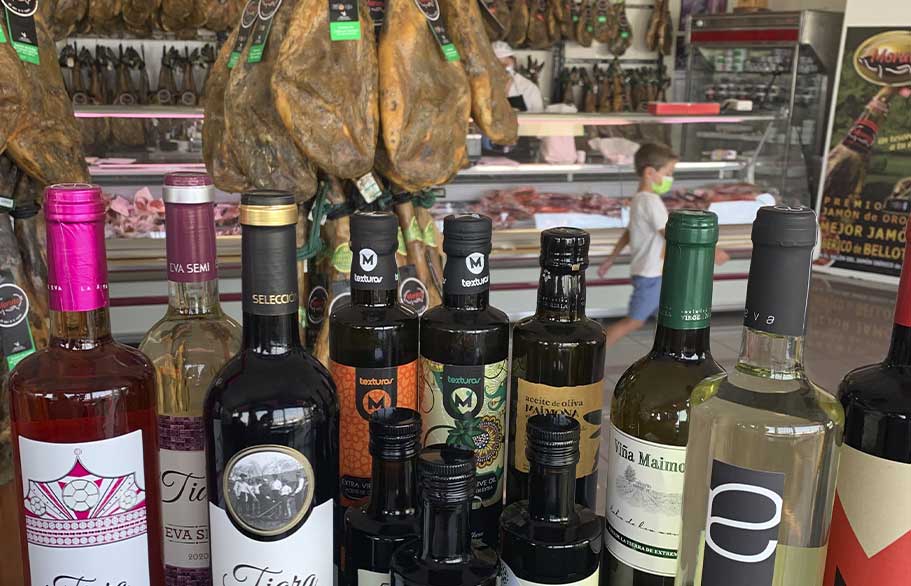Los Santos de Maimona is one of the best linked municipalities in the south of the province of Badajoz, being situated 75 km from Badajoz, 56 km from Mérida and 137 km from Seville.
Climate
It boasts a continental Mediterranean climate, with cool, fairly wet winters and hot, dry summers.
Setting
The municipality is located in a valley of rolling hills surrounded by mountain ranges that rise up to 660 metres above sea level traversed by the Robledillo Stream. This landscape affords it its unique beauty.
The low-lying countryside is mostly dry and clayey, except for the fertile farmland surrounding the town. Vines, olive trees, almond trees and cereals are grown here. Livestock mainly comprises pigs, sheep and cattle, though there are a number of poultry farms.
The area is rich in small game, with an abundance of partridge, rabbit, hare and migratory birds.
- Location: 38º 26′ 26″ N 2º 41′ 47″ W
- Elevation: 529 m
- Area: 108 km²
- Population: 8,249
- Density: 76.38 inhabitants/km²
- Name given to the local inhabitants: santeños/as
Access
Los Santos Maimona is one of the most accessible towns in the south of the Province of Badajoz. It is located on a crossroads and boasts the following major road and rail links:
- N-630 between Gijón and Seville (the Via de la Plata Route and the Way of St James), which also links up with the N-V to/from Madrid.
- N-432, linking Badajoz, Córdoba and Granada.
- N-435, linking Los Santos de Maimona and Huelva.
- Mérida-Seville-Huelva railway.
- The Autovía de la Plata dual carriageway
Más información
Although Stone Age man already walked these lands, it was around 2,500 BC, during the Chalcolithic period, when the first stable settlements arose within the present-day municipal area. The most important of these sites is probably the fortified settlement on the Sierra del Castillo range, as evidenced by the archaeological remains found there in the 1980s, now on show in the Municipal Museum.
The area continued to be populated through the Bronze and Iron Ages, but it was not until the arrival of the Romans around 50 BC when the extensive occupation and cohesion of the district of Los Santos de Maimona was to take place, constituting the borderland between the provinces of Hispania Lusitania and Hispania Baetica. There are accordingly many villas dotted around the municipality and even within the town itself. The Via de la Plata road ran through the area and other highways converged here, such as the Roman road from Astigi (Ecija) or the one that headed towards the area of Jerez de los Caballeros.
Some time later, in the aftermath of the Visigoth world, Lower Extremadura was to be occupied by the Moors, in the year 712. More specifically, this area was occupied by the Banu Maimum clan, part of the Masmuda Berber tribe, which possibly settled here and left their toponymic mark right up to the present day. This “surname” of Maimona was complemented by the name of Los Santos, which apparently derives from the Latin saltus, from its situation as a pass between mountain ranges.
In 1240, the area was re-taken by the Christians under the leadership of the Master of the Order of Santiago, Rodrigo Iñiguez, leaving the population under this order as head of the encomienda (protectorship). Shortly after, it was granted its charter as a town.
However, the town was not to achieve its greatest prosperity until the 16th century, the period to which its most important monuments belong, mainly thanks to the money that its Indianos (emigrants to the Indies) brought back from America.
Los Santos de Maimona has always been an eminently agricultural town, but in the 20th century, it enjoyed the benefits of modern industry. The simultaneous workings of the coalmines and cement factory led to the population reaching the figure of over 10,000 inhabitants in the mid-1960s.
Today, Los Santos is a modern town that has managed to combine its farming past with the advances of modernity and the new technologies, constituting a good place to visit and enjoy its climate and its people.
The local cuisine is based on pork products. Traditional pig slaughter carried out at home provides a wide range of exquisite cured products for the palate: loin, ham, spiced sausages (salchicón and chorizo), etc. Some local companies boast the Dehesa de Extremadura PDO certificate.
Among the most typical local dishes, visitors can enjoy succulent stews (chanfaina, fatigas and caldereta) wild mushrooms, savoury toast (tostás guisás), pipirigaña salad, fried breadcrumbs (migas) and the renowned en cantina salt cod.
There are also a number of internationally renowned olive and olive oil factories which have won numerous prizes and gold medals for their highly appreciated quality.

There are also excellent homemade baked pastries: perrunillas, roscas fritas, gañotes, prestines and the traditional Passover hornazos. Not to mention the puff pastry known as pastelón de hojaldre famous throughout the region.
The most popular drink, made from grape juice, is called “gloria” (glory). The local wineries also produce exquisite wines, most of which boast the Ribera del Guadiana PDO.
Along with olive and almond trees, vines constitute the most important crop in this locality. In addition to Eva or Beba table grapes, the numerous varieties of vines, bearing green and purple grapes, give rise to the great diversity of wines with endless shades of colour and flavour.
The colour is the most striking aspect of wine, which can give an idea of its past. If you look closely at a wine, you will discover aspects of its previous life.
The sugar in the grape is transformed by yeasts into alcohol and carbon dioxide, thus converting pressed grape juice into wine.
All these typical dishes and drinks can be tasted in the various local restaurants and taverns.
Further information at:
https://rutadelaplata.com/municipio/los-santos-de-maimona/?lang=en#eventos
Los Santos de Maimona is renowned for by its artisan lace and embroidery, both hand- and machine-made by a variety of specialists. Worthy of mention among the local embroiders is Carmen Ojeda, who was awarded First Prize for Handicrafts in 1998 by the Regional Government and in whose workshop many local women have worked.

There are also numerous artisans who work with iron and wood, such as Julian Magro and the brothers José and Juan Vera.
